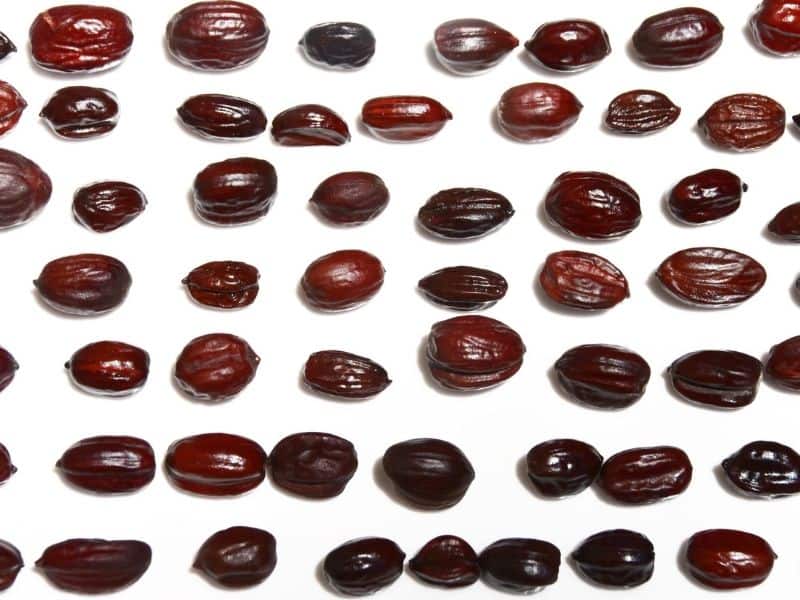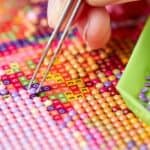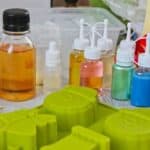Jojoba beads and microbeads are products many people are familiar with or have at least previously heard about. The jojoba is the natural and preferred choice when it comes to exfoliation, and microbeads are the artificial ones that are known for having the most negative aspects.
The two are found in beauty products used primarily for exfoliating the skin. They can also be found as an ingredient in some toothpaste brands as well.
The main difference between jojoba beads and microbeads is that jojoba beads have all-natural origins and microbeads are made synthetically from petroleum products. In addition, jojoba beads are known to be more gentle than microbeads.
However, each one has its own pros and cons and both can be great depending on the situation.

Uses Of Jojoba and Microbeads
Jojoba beads
Jojoba plants are native to North America. It’s a liquid wax ester that can be made into spherical jojoba beads. The word is pronounced as “jojoba”. What are Jojoba Beads used for?
Jojoba beads are used as exfoliators in soaps, scrubs, and cleansers. Jojoba beads are popular in manual exfoliators and are popular with environmentally friendly brands because they are naturally sourced and biodegradable.
They are mainly used as manual exfoliators. They are very popular amongst a lot of people because of their gentle nature, and they are naturally sourced as well. This is in comparison to different particles that are put in exfoliating scrubs; they vary from plastic microbeads, kernels, and ground seeds.
They are primarily found in different products such as polishes, soaps, masks, and scrubs. The use of jojoba beads has a lot of advantages linked to them.
One of the pros is that they are environmentally friendly, unlike plastic microbeads that have been proven to be very pollutive to marine life, and they are also non-biodegradable.
The spherical shape of the jojoba seeds makes them less abrasive compared to some types of natural exfoliators. The surfaces of the natural exfoliators are uneven. You can exfoliate more often with jojoba.
Microbeads
Plastic microbeads are a group of microplastics. They are very tiny in appearance, and sometimes it can be challenging to see them with the naked eye. Most people think they are plastic pellets, which are raw materials that are used to manufacture items. What are microbeads used for?
Microbeads are used in exfoliants and cleansers such as body washes, facial scrubs, and hand cleaners. They are very effective cleaners and have excellent scrubbing power. However, they are not biodegradable and or environmentally friendly.
The most common use of microbeads is in the manufacturing of exfoliants and cleansers. Other products that are manufactured with the microbeads include body washes as well as facial scrubs.
These are all products we love and depend on regularly when it comes to self-care. They are primarily used in these products because they have excellent scrubbing power. This makes them very effective when they are added. Toothpaste can also be manufactured with the use of microbeads.
However, microbeads in products are slowly losing popularity in several personal care product companies. These businesses are seeking much better alternatives.
The use of the beads has already been banned in different states. They are harmful to the environment and usually end up in the ocean, and affect a lot of marine life. They are very hard to filter and capture in most wastewater management systems.
Do Jojoba and Microbeads Cause Micro-tears?
Jojoba beads
When it comes to powerful oils that are great for your skin’s hydration, jojoba oil is one of the best. As we discussed earlier, jojoba beads are also great for exfoliation.
The beads are the hardened or fully hydrogenated form of the jojoba wax. Typically, they don’t have any odor or color since they are all-natural.
The structure isn’t very different from that of sebum oil secreted by the skin naturally. The consistency is also like that of sebum. Do jojoba beads cause micro-tears?
Jojoba beads will not cause micro-tears because of their perfectly round shape and their gentle structure. Jojoba is also known to reduce the amount of oil on your skin and help produce a more smooth complexion. For that reason, it is popular in facial cleansers.
This is due to the fact that when they are applied to the skin, the body will be tricked into thinking it’s just producing a lot of sebum, the correct amount required. When the skin does this, the oiliness nature of your skin will actually reduce.
This significantly reduces any chances of actually suffering from breakouts caused by acne. The shape also highly contributes to them not causing microtears. They have a spherical shape and are very smooth and tender on the skin for smooth exfoliating.
Microbeads
Microbeads are highly abrasive and therefore can be really harmful when used in toothpaste, washes, or scrubs. They have been used a lot over the years to make these products. When being advertised, you’re promised you’ll feel more attractive and clean.
However, the tiny particles are not only harmful to marine life, but they are also not good for our appearance. There are a lot of ways that they can be very harmful to our bodies.
One of the ways they can negatively affect you is by damaging the cornea. That’s the outer covering of the eye. It can be harmed when you’re washing your face. The microbeads get stuck inside your eye. Do microbeads cause micro-tears?
Microbeads can cause micro-tears. Micro-tears are harmful since they’ll let pollutants as well as bacteria into your skin. The end results typically cause a lot of spotting and also signs of early aging.
Typically, you can get rid of the residue naturally by just blinking. Nonetheless, other times the granules might not come out of your eyes; hence they remain lodged beneath your eyelids. The harm is caused when you close your eyelids.
The cornea might end up getting scratches. If this happens, your eyes remain very sore and turn red. It is a very dire situation that may lead to you ending up in the hospital for a short period of time.
Origins Of Jojoba and Microbeads
Jojoba Beads
Today more and more people are concerned with getting products that are more natural. People want to take better care of themselves and take better care of the environment. Are jojoba beads natural?
Jojoba beads are natural and very friendly to the environment. The beads are also biodegradable and provide your skin with natural exfoliation and get deep into the pores. The seeds are generally extracted from the Simmondsia Chinensis plant, which is an American shrub that’s usually found in Arizona.
Therefore when making a choice, it’s important to remember the jojoba beads are what you should go for when looking for exfoliation.
Microbeads
Microbeads are one of the cheapest options when considering which exfoliants to use. Are microbeads natural?
Microbeads are not natural exfoliators. The beads are manufactured from polyethylene or polypropylene. They are much cheaper options to choose from when compared to other natural exfoliants. They usually end up being washed down the drain, which happens to be very harmful to the environment.
They’re damaging both to people’s health as well as the creatures in the ocean. This is because of their composition as well as the ability to absorb toxins.
Jojoba Beads Are The Winner
In this comparison of exfoliants, jojoba beads are the clear winner. Providing superior exfoliating characteristics while being easier on your skin and the environment.
Jojoba Bead Related Questions:
Jojoba beads are used in a variety of soaps, scrubs, lotions, and cleansers for the purpose of exfoliating the skin. They come from jojoba oil that has been hydrogenated to create jojoba wax. They are all-natural and an excellent choice for today’s more conscious consumers.
Jojoba beads are good for the skin. They are excellent exfoliators for removing dead skill cells and cleaning the skin, but they are also gentle enough not to damage the skin and cause irritation. They will cleanse your pores and make your skin more receptive to your other care products.
You can use jojoba beads every day. Jojoba beads are gentle enough to be used in products that are part of an everyday skincare routine. They are great for face scrubs and for removing makeup.
Jojoba beads do dissolve. When used in a facial cleanser or scrub the jojoba beads will begin to dissolve as you rub them on your skin. In addition, as jojoba beads are washed down the drain and out to water treatment facilities they do not cause any of the issues caused by microbeads.
Conclusion
In conclusion, you have some really good options when it comes to choosing an exfoliator for your cleansers and soaps. However, microbeads likely should not be one of them. In this head-to-head matchup, jojoba beads are the clear winner.
They are gentle enough to be used in a daily face cleanser while still being tough enough to keep your skin clean and your pores clear.
In addition, it doesn’t hurt that they are WAY better for the environment than microbeads.





